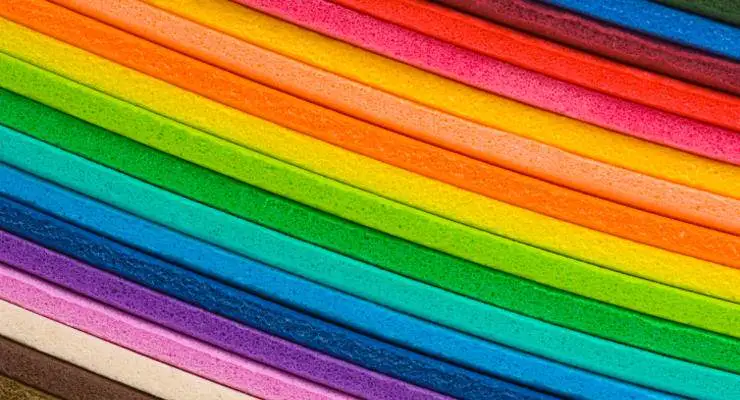What is felt?
Felt is a non-woven material of ancestral origin formed by the bonding of wool fibers or synthetic materials with steam and pressure.
This fabric with a velvety touch stands out for being resistant, moldable, soft, and warm.
Felt material is a truly unique and versatile material, and has played a fundamental role throughout human history. This material is formed by the bonding of wool fibers or synthetic materials through heat, pressure, and friction, resulting in a smooth and velvety surface that adapts to a wide variety of uses. Its origins date back to early Neolithic cultures, with evidence of its production in various cultures around the world.
In fact, it is considered one of the first textile materials created by humans. The most fascinating aspect of felt is its natural ability to regulate temperature, retaining heat in winter and providing coolness in summer. Throughout history, it has been appreciated for both its durability and flexibility. Today, it continues to be a valuable material used in the manufacture of a wide range of products, from clothing to decorative items.
What is felt used for?
Felt is a highly versatile material, so it is used in a wide variety of sectors due to all its unique properties. Some of its common applications include:
Fashion and Accessories
Felt is used in the making of clothing such as coats, custom backpacks, gloves, and scarves. It is also common in the creation of fashion accessories like custom purses and wallets.
Home Decoration
In home decor, it is used to create cushions, rugs, curtains, and other decorative elements. It is also popular in the manufacturing of furniture covers and wall coverings.
Stationery and Crafts
It is commonly used in the creation of custom cards, scrapbooks, and a wide variety of creative projects. Additionally, its ease of handling makes it an ideal educational tool to promote motor skills.
Automotive Industry
In the automotive industry, felt is used as a material for acoustic and thermal insulation inside vehicles, although it is mainly found in filtration components and seals.
Industrial Sector
In industrial applications, it is used to manufacture machinery parts, shock absorbers, seals, and gaskets, taking advantage of its ability to absorb oils and liquids.
Medical Sector
It is common in the manufacturing of dressings and absorbent materials due to its liquid retention capacity. It is also used in orthopaedic devices such as insoles and shoe liners, providing comfort and relief in foot care.
As we have seen, it is a truly multifaceted material that adapts to a wide range of applications in various sectors. Its ability to offer insulating properties, durability, and malleability makes it a very valuable and practical choice.
Properties of felt
Felt is a material that stands out for its insulation capacity, making it an excellent thermal regulator, retaining heat in winter and providing coolness in summer. It also acts as an efficient sound insulator, reducing unwanted noise in indoor spaces.
One of the most valued characteristics is its great malleability. This material can be easily molded into various shapes and sizes, making it extremely practical in both decorative and functional applications.
In addition, it is distinguished by its ability to absorb liquids while maintaining its integrity without decomposing, making it ideal for situations that require this property. In terms of durability, it is resistant to wear and can withstand continuous use without deteriorating quickly.
This feature makes it ideal for applications where resistance and long lifespan are required. Given its versatility and ability to stay in good condition over time, felt has become a highly valued element in personalized gifts for companies, ensuring that products maintain their quality and appearance for a long time.
Advantages of felt
Since its creation, felt has proven to be a material with many uses and unique characteristics that make it stand out in numerous ways. Among its multiple advantages are:
- Sustainability: Primarily manufactured from natural wool fibers, it is environmentally friendly and biodegradable.
- Hypoallergenic: Primarily manufactured from natural wool fibers, it is environmentally friendly and biodegradable.
- Lightweight: Despite its durability, it is very light, making it ideal for applications where weight is an important consideration.
- Ease of Dyeing: It dyes easily, allowing for a wide range of colour options and customization in final products..
- Wrinkle Resistance: It is naturally resistant to wrinkles, meaning products made with this material tend to maintain their shape and original appearance over time.
- Affordability: Compared to some similar materials, it is usually more affordable, making it an economical choice for various applications.
These benefits and properties make felt a highly valued material in a wide range of industries and diverse situations.
Varieties and types of felt in the market
This non-woven material comes in various forms depending on its manufacturing process and intended use. The main types of felt include:
Wool Felt
This type, the most traditional and natural, is made from wool fibers that are compacted and bonded through heat, pressure, and friction. It is known for being of the highest quality and is mainly used for crafts, although it tends to be more expensive due to its limited availability.
Synthetic Felt
It is created by perforating felt fibers with needles to improve density and strength. It is a popular choice in applications where greater durability is needed.
Compressed Felt sheet
It is obtained by compressing felt fibers into thick sheets. Its main use is in soundproofing and insulation applications due to its density and sound absorption capacity.
Needle-Felt
Similar to the needling process, but instead of needles, water, and soap are used to bind the fibers. It is commonly found in crafts and clothing due to its soft and malleable texture.
Industrial Felt
Produced in rolls or sheets, it finds application in the industry, where it is used in components such as gaskets and shock absorbers due to its ability to resist adverse conditions and provide insulation.
Self adhesive Felt roll
This type of felt includes an adhesive layer on one of its sides, facilitating its attachment in DIY projects and repairs, allowing for easy and secure application.
Amazing Products Made from Felt
Felt is a multifaceted and unique material found in a wide variety of products. Thanks to its numerous properties, it has become a popular choice in various industries, especially in the field of corporate gifts. This versatile fabric lends itself particularly well to the creation of personalized keychains, which stand out for their high-quality finish and pleasant touch. Additionally, due to its low maintenance and moisture resistance, it is commonly used in the manufacture of custom bags for travel and shopping bags.
Due to its humidity resistance, it is a material useful for customized necessaries, like office suppliers such as personalized pencil cases. Although personalized backpacks are less common than those made from other materials, they offer a stylish and durable option for those looking for such items. However, one of the most prominent uses is in the production of laptop cases, known for their ability to protect devices from scratches and bumps.
Recommended Marking Techniques for Felt
When marking or customizing felt products, it is essential to choose the appropriate marking technique to ensure good and lasting results on this material.
Laser Engraving
Laser engraving uses a laser to selectively remove felt fibers, creating detailed and precise designs. It is ideal for achieving an elegant and permanent look on products such as bags, labels, or stationery accessories.
Embroidery
Embroidery involves sewing threads into the felt to create textured and durable designs. It can be used to achieve intricate details and high-quality customization. Therefore, it is often recommended for clothing, custom caps, or patches.
Sublimation
Sublimation uses heat and pressure to transfer inks at a molecular level into the felt. It offers vibrant and durable colors, ideal for full-color designs such as cushions or coasters.
Screen Printing
Screen printing uses a stencil and ink to print designs on felt. It is effective for sharp and durable prints in large quantities. Therefore, the most recommended products are shopping bags and laptop sleeves.
Each marking technique has its advantages and is suitable for different types of felt products. The best choice will depend on your specific design, quantity, and budget needs.
What is the difference between felt and wool and lightweight felt?
Felt, lightweight felt, and wool are related materials with similar properties but distinctive differences that make them suitable for various tasks.
Lightweight felt
Synthetic felt made of polyester.
Thick and sturdy, projects with dimensions and volume.
Common in making dolls and toys, more moldable.
Allows sewing and embroidery with ease.
Felt
Manufactured by bonding wool fibers or synthetic materials.
Rigid and cardboard-like texture, does not fray.
Thermal and acoustic insulation.
Practical from crafts to industrial insulation.
Wool
Natural fiber obtained from sheep or other woolly animals.
Soft, warm, and breathable
Variety of patterns and textures.
Highly absorbent.
Each material has its own unique characteristics and is chosen according to the purpose and preferences of the project. Felt, for example, is denser and more robust, making it ideal for crafts and industrial applications. In contrast, lightweight felt resembles a woven fabric more, making it flexible and suitable for soft crafts. Wool, on the other hand, is a natural fiber, and its texture makes it better for knitting clothing.
What is the Cost of Felt Compared to Other Textile Materials?
The price of felt can vary considerably due to various factors. In general, felt made from natural wool tends to be more expensive compared to synthetic felt. This is due to its production process and the quality of natural wool fibers. The cost can also fluctuate depending on its thickness and the size of sheets or rolls required for a specific project. Additionally, it is essential to note that prices may vary depending on the supplier and geographical location, meaning there could be regional differences in the price.
Compared to other textile materials such as cotton and polyester, felt tends to be more expensive due, in part, to its manufacturing process. However, in comparison to wool, it can be more affordable, as it is made with woven threads. Although felt made from natural wool may have a slightly higher price compared to synthetic varieties, this additional investment is usually offset in terms of durability and performance. This makes it a valuable choice, especially for projects that need to be robust and long-lasting.
Is Felt Recyclable and Eco-Friendly?
Felt is a material that raises significant environmental considerations. Regarding recycling, felt made with natural wool is biodegradable and naturally decomposes over time, making it an environmentally friendly choice. However, some types of synthetic felt, made with materials like polyester or acrylic, may not be biodegradable and may have a more negative environmental impact.
In terms of production, it typically requires fewer resources compared to more complex fabrics, making it a more eco-friendly option. Additionally, its durability and resistance mean these products tend to have a long lifespan, reducing the need for frequent replacements and ultimately being more environmentally friendly in the long run.
Conclusions
Felt is a flexible material that has found a prominent place in the promotional gifts' industry. Its ability to adapt to a wide range of products makes it an attractive choice for companies looking to offer promotional gifts that are unique and memorable for their customers and employees. This highlights the company's attention to detail and communicates a strong sense of appreciation towards the recipients, establishing a stronger connection between the brand and those who receive it.
Furthermore, the durability and aesthetic appeal reinforce the brand's image. These types of products are not only valued at the time of delivery but also endure over time, maintaining their quality and utility. This longevity ensures that promotional gifts continue to maintain their shape over time, strengthening the perception of the company.








